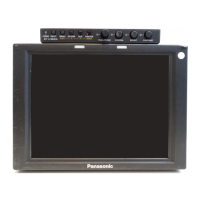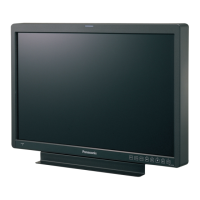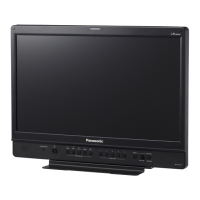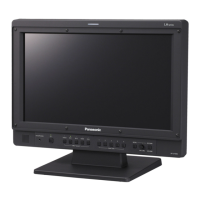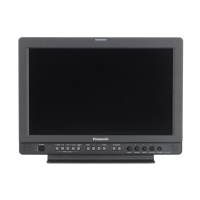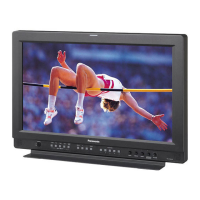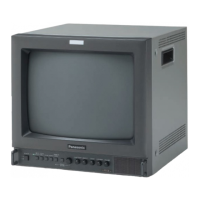71
BRIGHTNESS ADJUSTMENTS (NTSC/PAL Y/C)
Measuring Instruments Signal generator (Gray scale signal)
Card (Slot) NTSC/PAL Video Input Card (Slot 2)
Test Points
Adjustment Points S*02 (4:3 Overscan Bright High), S*06 (4:3 Overscan Bright Low),
SM** (4:3 Underscan Bright High/Low),
SN** (16:9 Overscan/Underscan Bright High/Low) [Service Menu]
Notes: • Ensure that the output waveforms from the NTSC/PAL Video Input Cards are
normal before proceeding to the following adjustments (see page 72).
• Perform the following adjustments after completing the 1080/60i Brightness Ad-
justment.
• Set the SUB PICTURE ADJ. data in the Setup Menu to "00".
• The SO value (see the description for the HDTV Brightness adjustment) becomes
the reference value for the following adjustments. When this data is changed, it
is required to re-adjust the data of all of the adjustment signals (HDTV, SDTV and
NTSC/PAL).
When re-adjusting the 1080/60i signal, use the SI. (For the adjustment of the
1080/60i signal, use the Component/RGB Input Card.)
• When overscan data of a signal is changed, it is required to re-adjust the
underscan data of the same adjustment signal.
• When the 4:3 data of a signal is changed, it is required to re-adjust the 16:9 data
of the same adjustment signal.
• After completing the brightness adjustments, make sure that the Low-Light is
not deviated. If it is, it is required to perform the Low-Light adjustment again.
0% Black area
0
%
2 4 6 8 10 12 14 0
%
2 4 6 8 10 12 14
%
<White Balance HIGH: D9300>
1. Apply the NTSC gray scale signal to INPUT D (Terminal Y/C of
the NTSC/PAL Video Input Card).
2. Set COLOR TEMP. of "COLOR TEMP./BAL." in the Setup Menu to
HIGH.
3. Set the PHASE, CHROMA, BRIGHT and CONTRAST
potentiometers on the front panel to the center click positions.
4. Adjust SB02 in the Service Menu so that the 0% black area in the
gray scale signal lights up slightly. (Be sure to avoid degradation
of the black color.)
5. Set the ASPECT button on the front panel to ON so that the scan-
ning size is 16:9.
6. Adjust SN08 so that the 0% black area in the gray scale signal
lights slightly. (Be sure to avoid degradation of the black color.)
7. Set the ASPECT button on the front panel to OFF and the UNDER
SCAN button to ON to set the scanning size to underscanning for
the 4:3 ratio.
8. Adjust SM05 so that the 0% black area in the gray scale signal
lights up slightly. (Be sure to avoid degradation of the black color.)
9. Set the ASPECT button on the front panel to ON to set the scan-
ning size to underscanning for the 16:9 ratio.
10. Adjust SN11 so that the 0% black area in the gray scale signal
lights slightly. (Be sure to avoid degradation of the black color.)
11. Set the ASPECT and UNDER SCAN buttons on the front panel to
OFF.
<White Balance LOW (D65)>
12. Set COLOR TEMP. of "COLOR TEMP./BAL." in the Setup Menu
to LOW.
13. Adjust SB06 so that the 0% black area in the gray scale signal
lights slightly. (Be sure to avoid degradation of the black color.)
14. Set the ASPECT button on the front panel to ON so that the scan-
ning size is 16:9.
15. Adjust SN09 so that the 0% black area in the gray scale signal
lights slightly. (Be sure to avoid degradation of the black color.)
16. Set the ASPECT button on the front panel to OFF and the UN-
DER SCAN button to ON to set the scanning size to underscanning
for the 4:3 ratio.
17. Adjust SM06 so that the 0% black area in the gray scale signal
lights slightly. (Be sure to avoid degradation of the black color.)
18. Set the ASPECT button on the front panel to ON to set the scan-
ning size to underscanning for the 16:9 ratio.
19. Adjust SN12 so that the 0% black area in the gray scale signal
lights slightly. (Be sure to avoid degradation of the black color)
20. Set the ASPECT and UNDER SCAN buttons on the front panel to
OFF.
21. Vary the adjustment signal and adjustment data, and re-perform
adjustments in steps 1 to 20 above (see Table 24).
Adjustment
White Balance HIGH White Balance LOW
Signal
Overscan Underscan Overscan Underscan
4 : 3 16 : 9 4 : 3 16 : 9 4 : 3 16 : 9 4 : 3 16 : 9
NTSC(Y/C) SB02 SN08 SM05 SN11 SB06 SN09 SM06 SN12
PAL(Y/C) SD02 SN20 SM11 SN23 SD06 SN21 SM12 SN24
Table 24

